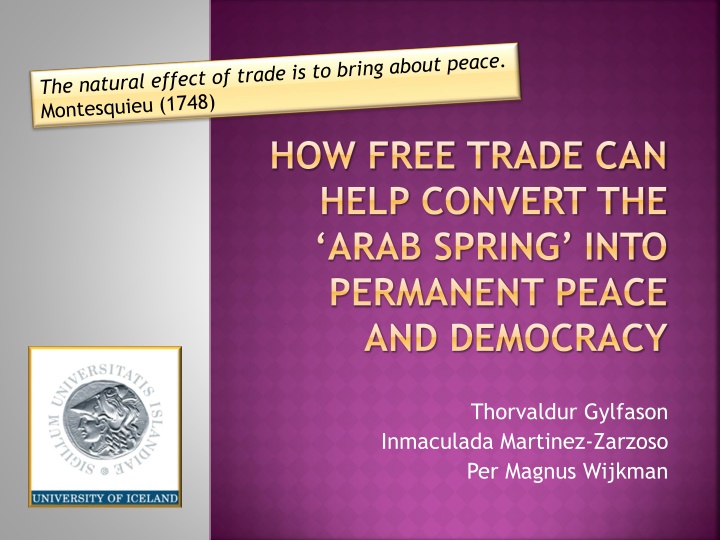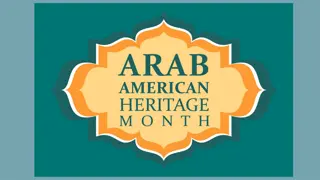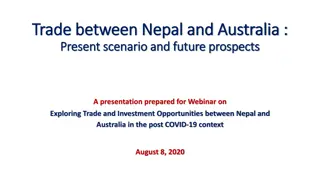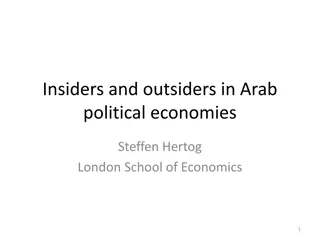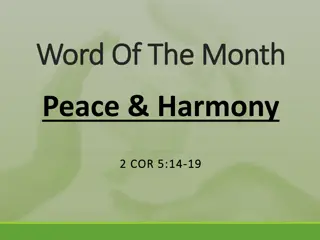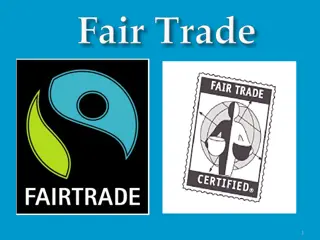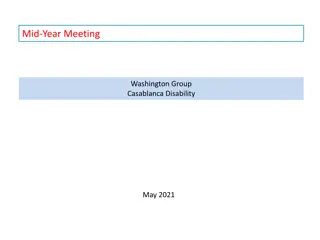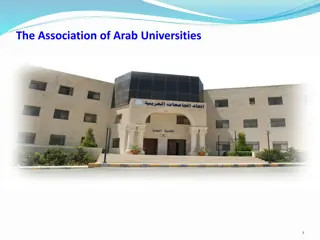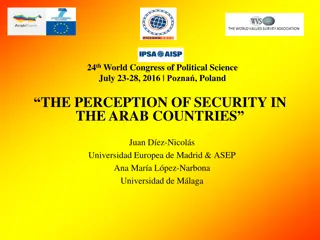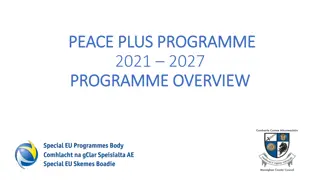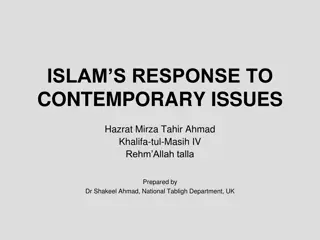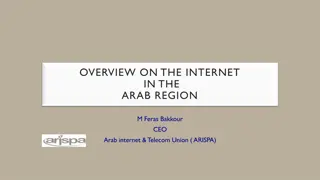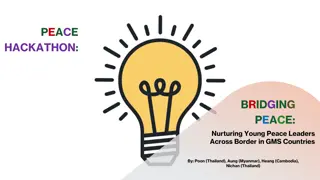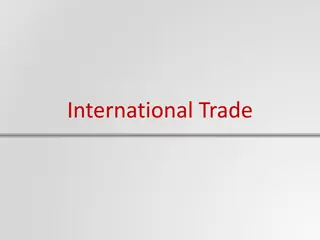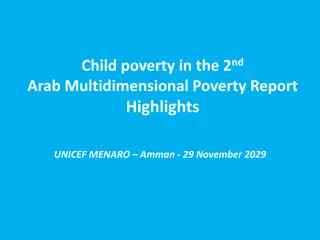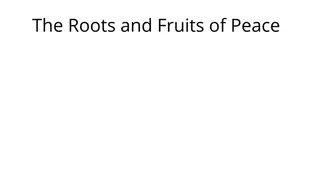Enhancing Arab Spring Through Free Trade for Peace
Free trade agreements can play a vital role in transforming the Arab Spring into lasting peace and democracy by fostering economic integration and cooperation among Arab countries. The European Neighborhood Policy (ENP) aims to resolve conflicts in the EU's neighborhood through economic integration, trade facilitation, and market-oriented reforms. By promoting intra-regional trade and creating incentives for accession to the EU, free trade can pave the way for stability and prosperity in the region.
Download Presentation

Please find below an Image/Link to download the presentation.
The content on the website is provided AS IS for your information and personal use only. It may not be sold, licensed, or shared on other websites without obtaining consent from the author.If you encounter any issues during the download, it is possible that the publisher has removed the file from their server.
You are allowed to download the files provided on this website for personal or commercial use, subject to the condition that they are used lawfully. All files are the property of their respective owners.
The content on the website is provided AS IS for your information and personal use only. It may not be sold, licensed, or shared on other websites without obtaining consent from the author.
E N D
Presentation Transcript
HOW FREE TRADE CAN HELP CONVERT THE ARAB SPRING INTO PERMANENT PEACE AND DEMOCRACY Thorvaldur Gylfason Inmaculada Martinez-Zarzoso Per Magnus Wijkman
TWO COMPANION PAPERS How Free Trade Can Help Convert the Arab Spring into Permanent Peace and Democracy With Inmaculada Mart nez-Zarzoso (G ttingen) and Per Magnus Wijkman (Gothenburg) CESifo Working Paper No 3882, July 2012 Which Conflicts Can the European Neighborhood Policy Help Resolve? With Per Magnus Wijkman Presented at a conference on Globalization, Strategies and Effects at Aarhus University in November 2011, forthcoming in conference volume CESifo Working Paper No. 3861, June 2012
SAME STORY, TWO RENDITIONS ENP story Old Balkan powder keg and what the EU can do to facilitate peace through free trade agreements (FTAs) and integration Arab Spring story How remarkably little the Arab countries trade with one another and how much they could benefit from more trade and integration plus a well-functioning market economy and more My coauthors Mart nez-Zarzoso: Gravity model econometrics Wijkman: Trade policy, hands on experience
SAME STORY, TWO RENDITIONS ENP story Old Balkan powder keg and what the EU can do to facilitate peace through free trade agreements (FTAs) and integration Arab Spring story Uses a panel gravity model of trade to estimate potential for increased intra-regional trade among 10 countries of the Southern and Eastern Mediterranean coast of the EU Two initiatives Barcelona Process 1995 aimed at South-Med coast ENP 2004 aimed at Southern and Eastern neighbors
ENP STORY: MAIN AIM OF ENP Resolve conflicts in EU s neighborhood Basic hypothesis (Montesquieu, Monnet): Closer economic integration helps resolve political conflicts and vice versa, creating a virtuous circle of prosperity and d tente Strong self-interest in resolving conflicts because their consequences spill over into EU Identify four keys to success Existence of facilitators of compromise (EU) Well-functioning market economy Intra-regional trade plus FTAs Prospect of accession to EU: Strong incentive
Thessaloniki Declaration (2003): future of the countries of the Western Balkans lies in the EU ENP STORY: MAIN PLAYERS Acknowledged candidates for full EU membership Croatia: Expected to join 2013 Turkey and Macedonia: Uncertain time table Montenegro: Negotiations underway Serbia: Needs to normalize relations with Kosovo Potential candidates Albania and Bosnia-Herzegovina Unacknowledged potential candidates Belarus, Moldova, Ukraine: In Europe Armenia, Azerbaijan, Georgia: Not in Europe
TWO DIMENSIONS OF FTAS AFFECTING INCENTIVES Few Many Countries Doubly difficult Extra strong incentives Difficult Stronger incentives Countries Difficult Stronger incentives Deep Agreement Shallow Agreement Easy Weak incentives
CONFLICT CLASSIFICATION Conflicts confined to region Conflicts involving third countries Ukraine-Moldova- Transnistria (Russia) Georgia-South Ossetia-Abkhasia (Russia) Potential candidate countries Western Balkans (Kosovo-Serbia, Bosnia-Herzegovina) Not potential candidate countries Western Sahara (Morocco-Algeria) Middle East (Israel, Palestine, and neighbors) Armenia- Azerbaijan-Nagorno Karabakh (Russia, Turkey)
INTRAREGIONAL AND EU TRADE SHARES 2005 (% OF TOTAL) 70 60 Regional EU 50 40 30 20 10 0 Balkans EaP S. Mediter
BALKAN COUNTRIES: EXPORTS TO NEIGHBORS 2005 (% OF TOTAL) 70 60 50 40 30 20 10 0 to Balkans to EaP to S E Med to Other to EU 25 to East EU to South EU
BALKAN COUNTRIES: IMPORTS FROM NEIGHBORS 2005 (% OF TOTAL) 70 60 50 40 30 20 10 0 from Balkans from EaP from S E from Other from EU 25 from East EU from South EU Med
SOUTH-MED COUNTRIES: EXPORTS TO NEIGHBORS 2005 (% OF TOTAL) 60 50 40 30 20 10 0 to Balkans to S E Med to EU 25 to South EU to East EU
GDP PER CAPITA 1990-2010 (PPP, CONSTANT 2005 INTERNATIONAL $) 14,000 12,000 10,000 Armenia Azerbaijan Belarus Georgia Moldova Ukraine 8,000 6,000 4,000 2,000 0
EAP COUNTRIES: EXPORTS TO NEIGHBORS 2005 (% OF TOTAL) 40 35 30 25 20 15 10 5 0 to others to EaP to CIS to Balkans to S and E to EU 25 Mediterr
TWO DIMENSIONS OF DCFTAS EU DEEP AGREEMENT ? EEA NEC ? EFTA NEC ?? EaPbilaterals CEFTA Agadir+ countries PAFTA Non- Agadir countries EaP CIS agreement Balkan bilaterals SHALLOW AGREEMENT FEWCOUNTRIES MANY COUNTRIES
KEY ELEMENTS OF NEW ENP European Endowment for Democracy and Civil Society Facility Deep and comprehensive free trade agreements with EU (cf. EaP) with Large potential gains from trade and Incentives to include key partners in the region, including Extensive financial and technical aid Secure institutional anchoring (NEC)
ARAB SPRING Challenge comparable to that following collapse of communism Systemic changes requires 1. Change in personnel managing the system 2. Implementation of basic principles of a market economy 3. Foreign financial and technical assistance 4. Sharing common values and adopting common principles, presupposing a strong sense of community solidarity
INTRA-REGIONAL AND EU TRADE SHARES 2005, AGAIN (% OF TOTAL) 70 Regional 60 EU 50 40 30 20 10 0 Balkans EaP S. Mediter
AGADIR 4 REGIONAL EXPORT SHARES (% OF TOTAL) 14 Agadir 4 to other PAFTA 12 Agadir 4 to Agadir 4 10 8 6 4 2 0
NON-AGADIR 4 REGIONAL EXPORT SHARES (% OF TOTAL) 7 6 5 4 3 2 %nonAgtononag 1 %nonAgto Agadir 0
POOR PROSPECTS History of failed attempts to integrate MENA Long embedded conflicts Israel/Palestine Lebanon/Syria Western Sahara Malfunctioning democracies Prolonged civil strife in Algeria, Egypt, Libya, Syria, Lebanon Imperfect market economies Entrenched military industrial complexes
BUT HISTORIC OPPORTUNITY Large economic gains from trade if successful MENA states have high tariffs and extensive non-tariff barriers Intra-regional trade is exceptionally small, so large gains are possible Large potential for FDI in MENA to supply EU markets
THUS FAR, LIMITED SUCCESS Main reasons for failure Incomplete barrier coverage Most FTAs are shallow, not deep, excluding barriers inside border Incomplete commodity coverage EU s FTAs exclude agricultural products Incomplete country coverage of FTAs PAFTA excludes Israel
ESTIMATING MODEL lnXijt= 0+ 1FTAijt+ ij+ it+ jt+ ijt ijdenotes binary fixed effects, specified as dummy variables for each bilateral relation itare exporter-and-time fixed effects jtare importer-and-time fixed effects FTAijtdenotes FTAs and varies by origin, destination, and over time
RESULTS: EFFECTS OF FTAS ON TOTAL EXPORTS AND IMPORTS Imports 0.243*** (0.083) 0.081 (0.183) Exports -0.128 (0.139) Imports = MENA total imports from the 64 economies that represent 90% of their total imports EUMED Interpreting the results: Intra-Agadir trade is around 46 percent higher after the entry into force of the agreement as e0.376 1 = 0.456 EFTAMED 0.000 (0.205) USAMED -0.223 (0.502) 0.593*** (0.206) 0.551 (0.357) 0.376* (0.216) 0.412** (0.173) 11006 0.293 1.129 -16254.2 1.363 (0.975) TURMED 0.407 (0.394) PAFTA -0.062 (0.327) AGADIR 0.208 (0.225) 0.610*** (0.232) 10405 0.117 0.688 -10180.34 Exports = MENA total exports to the 64 economies that represent 90% of their total exports TUREU NOBS R2-Adjusted RMSE LL
RESULTS: EFFECTS OF FTAS ON TOTAL EXPORTS AND IMPORTS Specific results Intra-PAFTA exports have increased significantly, by around 67% EU exports to Turkey have increased by around 67% Exports from Turkey to EU have increased by 50% Turkish exports to Mediterranean countries increased on average by 80% Israel s imports from Turkey have quadrupled after 1997, controlling for distance, common border, incomes and incomes per capita
FURTHER RESULTS (NOT SHOWN) The effect of the Turkey-Israel agreement has been to Triple Israel s imports from Turkey and Increase Israel s exports to Turkey by 80% Significant benefits would emerge from an FTA between Egypt and Israel (Egger and Larch, 2007)
TO SUCCEED THE ENP MUST Incude NTBs to trade Include agriculture in bilateral DCFTAs between EU and MENA countries Initiate a regional DCFTA between Egypt, Israel, Jordan Expand this to other MENA states by making participation in regional DCFTA a condition for a DCFTA with EU Clarify the proposed NEC institutions
TO SUCCEED THE ENP MUST Ensure agreement between participating Member States Respect stronger conditionality Reward fullfilment of goals More for more Devote greater resources to: DCFTAs Reward conflict resolution (for Turkey? For the ME states? For Morocco-Algeria?) THE END
